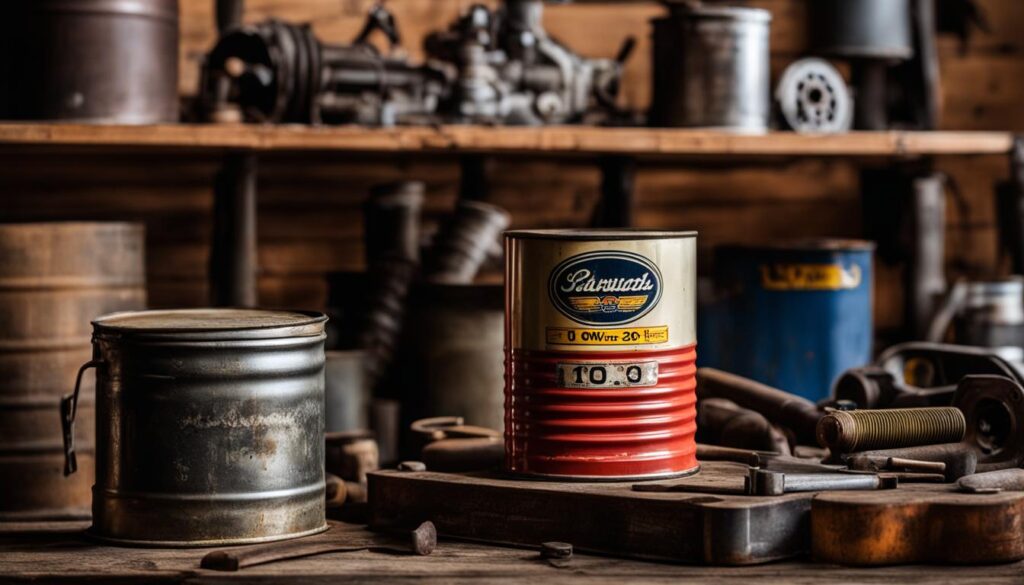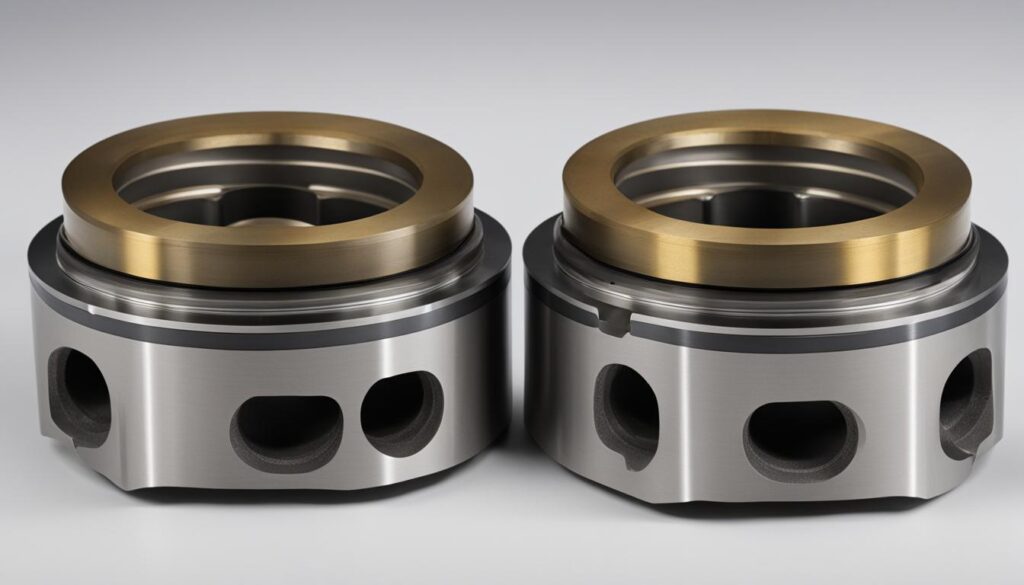When it comes to maintaining your vehicle’s engine, choosing the right motor oil is crucial.
In this article, we’ll tackle the ongoing debate between 10w 30 oil vs 5w30 and uncover the differences between 10w 30 oil and 5w30 that impact engine lubrication and performance.
Being informed and understanding motor oil viscosity is key to making the best choice for your vehicle, as it directly influences oil performance and, ultimately, which is better 10w 30 or 5w30 for your specific needs.
- Understanding Motor Oil Viscosity and Why It Matters
- The Origins of 10w30 and 5w30 Oils
- Examining 10w30 Oil: Pros and Cons
- Highlighting 5w30 Oil: Advantages and Limitations
- Comparing 10w30 and 5w30: Viscosity in Low Temperatures
- High Temperature Viscosity: 10w30 vs 5w30 Oil
- Synthetic vs Conventional: How Oil Types Affect Viscosity Ratings
- Understanding SAE Ratings and API Classes for Engine Oils
- Impact of Viscosity on Fuel Efficiency and Oil Consumption
- The Debate on Engine Protection: 10w30 vs 5w30
- Avoiding Common Misconceptions About Motor Oil Grades
- Optimal Choices for Specific Engine Types
- Conclusion
Understanding Motor Oil Viscosity and Why It Matters
Oil viscosity refers to the resistance of the oil to flow and can be considered as the thickness of the oil. It plays a crucial role in affecting how the oil performs in lubricating engine parts, depending on the operating temperature.
To make informed decisions regarding motor oil for your vehicle, it is essential to understand the significance of oil viscosity and its impact on various aspects of engine performance.
What Does Oil Viscosity Mean?
Motor oil viscosity is denoted by a grade, such as 10w30 or 5w30, with the lower the first number before the ‘W’ indicating better performance in cold temperatures.
The ‘W’ in the rating stands for ‘winter,’ representing the oil’s effectiveness in colder climates. This property influences the oil’s capacity to flow quickly and provide protective lubrication during engine startup.
A correct viscosity choice ensures efficient heat transfer, crucial in maintaining desired oil pressures and preventing engine components from excessive wear and damage.
Importance of the Right Viscosity in Engine Performance
Selecting the appropriate viscosity is essential to optimize engine performance and longevity. For instance, 5w30 oil provides better engine protection in colder climates and improved fuel efficiency due to its thinner nature at low temperatures.
Conversely, 10w30 oil is preferable in warmer climates due to its slightly higher viscosity, which offers better lubrication for vehicles under heavy loads.
Choosing the right motor oil viscosity is vital for maximizing engine protection, fuel efficiency, and overall performance, regardless of the operating conditions.
How Viscosity Affects Your Engine in Different Climates
Viscosity plays a pivotal role in how engines perform across various climates. Oils like 5w30 are ideal for both hot and cold climates due to their broad operational temperature range, while 10w30 oils may be better suited for slightly warmer temperatures.
In cold weather, an oil’s lower viscosity helps in quicker circulation, reduced engine wear during startup, and increased fuel efficiency.
Conversely, higher viscosity at operating temperatures ensures effective lubrication, reduces oil consumption, and prolongs the lifetime of the engine components.
- 5w30 oil: ideal for a wide range of climates, providing better engine protection in colder climates and improved fuel efficiency due to its thinner nature at low temperatures.
- 10w30 oil: suitable for warmer climates or vehicles that experience heavy loads or require a slightly thicker film for improved lubrication.
Ultimately, understanding motor oil viscosity, its implications for engine performance, and how it varies in different climates is fundamental to making informed decisions about the most suitable oil for your vehicle, ensuring optimal engine protection and peak performance.
The Origins of 10w30 and 5w30 Oils

The development of multi grade oils in the history of engine oils marked a significant shift from the era of single-grade motor oil grades, which could not offer adequate protection in the wide range of temperatures that engines face today.
This advancement in automotive maintenance began in the mid-20th century, as car manufacturers started to realize the need for a versatile oil that could cater to a broader spectrum of temperature requirements.
Before the advent of multigrade oils, engineers and mechanics had to rely on different single-grade oils for cold and hot weather conditions. It was a cumbersome process that carried the risk of costly engine damage if the wrong oil was used.
As a breakthrough in lubrication technology, 10w30 and 5w30 oils were introduced to provide comprehensive engine protection by dynamically adjusting to ambient and engine operating temperatures.
This adaptability was achieved thanks to numbers before and after the ‘W’ in their viscosity rankings, signifying cold and normal operating requirements respectively.
To better understand how the development of multigrade oils transformed the automotive lubrication landscape, let’s delve into its main benefits:
- Enabled all-season engine protection
- Reduced the need for frequent oil changes
- Improved engine efficiency and wear resistance
- Provided better cold start protection
These advantages made it possible for motorists to enjoy a level of convenience and reliability previously unheard of in traditional single-grade lubricants. The result?
Enhanced engine performance and longevity for vehicles operating in a diverse range of climates and conditions.
| Oil Type | Viscosity | Temperature Range | Applications |
|---|---|---|---|
| Single-Grade Oils | Non-adaptive viscosity | Limited (specific to each grade) | Seasonal, outdoor temperatures limited |
| 10w30 and 5w30 Multigrade Oils | Adaptive viscosity | Wide-ranging (broad spectrum) | All-season, versatile engine protection |
In conclusion, the historical development of 10w30 and 5w30 motor oil grades led to an unprecedented breakthrough in engine protection, effectively paving the way for the modern vehicle maintenance practices that we rely on today.
Gaining a deeper understanding of their origins and their functional benefits can help you appreciate the crucial role they play in keeping your engine running smoothly and efficiently.
Examining 10w30 Oil: Pros and Cons
When it comes to motor oil, there are several essential factors to consider, such as climate, engine type, and vehicle use, that dictate the most appropriate choice.
High viscosity oils like 10w30 exhibit certain advantages and adapt better to specific situations compared to lower viscosity alternatives.
In this section, we will explore the benefits of 10w30 oil and situations when its use is highly recommended.
Benefits of High Viscosity Oils
One major advantage of using 10w30 oil involves its high viscosity properties. High viscosity oils like 10w30 offer superior engine lubrication and reduced wear, particularly in hot weather conditions or for vehicles operating under heavy loads.
They have the ability to maintain protective film strength at higher temperatures and resist breakdown, leading to less oil consumption and potentially extending oil change intervals.
10w30 oil provides advantages related to reduced wear on engine parts over time, contributing to better longevity and performance of the vehicle.
When to Choose 10w30 for Your Vehicle
Selecting 10w30 oil is appropriate for vehicles that consistently carry heavy loads or operate in warmer climates.
The oil ensures adequate lubrication and reduces bearing and cylinder heat, guarding against engine damage due to high-temperature stress. Some typical use cases for 10w30 oil include:
- Heavy-duty vehicles or trucks: Vehicles with higher load-carrying capabilities often generate more heat, requiring thicker oil like 10w30 to maintain proper lubrication and protection.
- High-performance engines: Engines with high horsepower output generate more heat, and a high viscosity oil like 10w30 can provide the necessary lubrication for optimal performance.
- Consistently warm climates: In regions, where temperatures remain on the higher side, engines can benefit from the additional heat and wear protection offered by 10w30 oil.
By understanding the benefits and recommendations for 10w30 oil, you can make an informed decision in choosing the best oil for your specific vehicle and driving conditions. Prioritizing engine protection and matching the oil to your engine’s unique requirements is crucial to extending the life of your vehicle and maintaining optimal performance.
Highlighting 5w30 Oil: Advantages and Limitations
The benefits of using 5w30 oil are primarily observed in its cold-weather performance, thanks to its lower viscosity that ensures smoother engine startups and better fuel efficiency.
This oil caters well to both private vehicles and light-duty engine requirements, offering versatility for various climates.
However, it might not be the optimum choice for more demanding conditions or high-load engines where a thicker oil would be more appropriate.

5w30 motor oil is excellent for cold-weather performance, providing smoother engine startups and improved fuel efficiency.
- Better fuel efficiency due to its lower viscosity
- Reduced wear on engine components during colder temperatures
- Provides quicker lubrication in colder climates
- Caters to both private vehicles and light-duty engines
Despite its many advantages, 5w30 oil does have some limitations. Given its lower viscosity, this oil may not be suitable for more strenuous conditions or heavy-load engines that could benefit from higher viscosity oils.
Additionally, some vehicles might experience higher oil consumption while using 5w30, leading to more frequent oil changes.
| Advantages | Limitations |
|---|---|
| Excellent cold-weather performance | Not ideal for heavy-load engines |
| Better fuel efficiency | Potentially higher oil consumption |
| Reduced wear on engine components | Not suitable for demanding conditions |
| Versatile oil suitable for various climates | Not always the optimal choice |
As a car owner, understanding the benefits of using 5w30 oil as well as its limitations can help you make an informed decision when selecting motor oil for your vehicle.
Always refer to your vehicle manufacturer’s recommendations and consult with automotive professionals to maintain optimal engine performance and protection.
Comparing 10w30 and 5w30: Viscosity in Low Temperatures
When it comes to motor oil, the viscosity performance in low temperatures plays a crucial role in ensuring protection and optimal engine performance.
This section will specifically focus on the capabilities of 5w30 and 10w30 oil in cold weather conditions and their respective use cases in cooler environments.
5w30’s Performance in Cold Weather
One of the most significant advantages of 5w30 in cold weather is its lower viscosity, which allows for easier flow and quicker lubrication of engine components during startup.
This is particularly important for cold weather starting, as it ensures the engine remains protected against wear and tear even during harsh winter conditions.
With a design that operates efficiently in temperatures as low as -22°F, 5w30 oil offers reliable protection against wear when working in cold environments.
Best Use Cases for 10w30 in Cooler Environments
While 10w30 may not be as efficient as 5w30 in extremely cold temperatures, it still provides adequate performance in cooler but not freezing conditions.
This 10w30 cold weather application is suitable for temperatures as low as 0°F, making it a good choice for areas with mild winters.
When deciding when to use 10w30 in cold weather, consider vehicles that require a slightly thicker oil for added protection. For instance, vehicles carrying heavier loads or operating in consistently warmer climates can benefit from the enhanced lubrication of 10w30 oil.
While 5w30 oil offers superior performance in low temperatures, 10w30 can still provide adequate protection in cooler environments, ensuring smoother engine operation during mild winter conditions.
| Oil Grade | Temperature Range | Best Use Cases |
|---|---|---|
| 5w30 | As low as -22°F |
|
| 10w30 | As low as 0°F |
|
In conclusion, understanding the different cold weather applications of 5w30 and 10w30 oils will help you make an informed decision based on your vehicle’s requirements and typical operating conditions.
Although 5w30 boasts a superior low temperature performance, 10w30 oil still offers satisfactory protection in cooler environments, making it a suitable choice depending on your specific needs.
High Temperature Viscosity: 10w30 vs 5w30 Oil
Both 10w30 and 5w30 oils are designed to function effectively across a range of temperatures, but their performance varies when it comes to high-temperature viscosity.
To better understand their differences in high-temperature situations, let’s compare the two head-to-head:

- Viscosity at operating temperature: Generally, the viscosity of both 10w30 and 5w30 oils remains consistent at the typical engine operating temperature of 212°F. Nonetheless, slight variations in their compositions can affect how they perform at higher temperatures.
- 10w30 heat resistance and oil consumption: The slightly thicker composition of 10w30 oil at warmer temperatures can provide some advantages such as better engine protection for vehicles under strenuous conditions and reduced oil consumption.
- Best applications for 10w30 oil: Given its heat resistance, 10w30 is a preferred choice for high-temperature environments or vehicles exposed to heavy-duty use, such as commercial trucks and construction equipment.
In conclusion, the primary difference in high-temperature viscosity between 10w30 and 5w30 oils lies in their composition and performance when subjected to higher temperatures and stress.
While the two oils are quite similar overall, 10w30 may offer improved performance for those in hotter climates or when used in heavy-duty applications.
Synthetic vs Conventional: How Oil Types Affect Viscosity Ratings
The Difference Between Synthetic and Conventional Oils
Synthetic oils are engineered with modified molecular structures that afford them better performance in extreme temperatures, both high and low.
They tend to hold up better than conventional oils, particularly in severe cold weather, due to their ability to resist thickening.
Conventional oils, though less expensive, may not provide the same level of protection in fluctuating temperatures as their synthetic counterparts.
What’s Best for Your Engine? Synthetic or Conventional Oil
The choice between synthetic and conventional oil depends on the specific requirements of your vehicle’s engine and the operating conditions it typically encounters.
Synthetic oils are generally recommended for their superior protection, especially in extreme weather or for engines under higher stress, while conventional oils may suffice for less demanding use.
Consulting your manufacturer’s guidelines can aid in making the best decision for engine longevity and performance.
Knowing the right oil choice for engine protection and considering your engine’s operating conditions are crucial factors in determining whether to use synthetic or conventional oil.
Understanding the benefits and limitations of each oil type can help you make an informed decision about the most suitable engine lubrication option for your vehicle. Here’s a comparison table highlighting some key aspects:
| Aspect | Synthetic Oil | Conventional Oil |
|---|---|---|
| Temperature Range | Performs well at both high and low temperatures | May not perform as well in extreme temperature fluctuations |
| Durability | Extra resistance to breakdown, offering longer-lasting protection | Less resistant to breakdown, may require more frequent oil changes |
| Energy Efficiency | Reduced friction and increased fuel efficiency | May provide sufficient protection, but with less fuel efficiency |
| Price | Generally more expensive | More affordable option |
Considering the specific requirements of your engine, operating conditions, and manufacturer’s guidelines, you should be able to make an informed choice between synthetic and conventional oil for optimal protection and performance.
Understanding SAE Ratings and API Classes for Engine Oils
When it comes to selecting the right motor oil for your vehicle, understanding the various oil specifications can be very helpful. Among these specifications are the SAE ratings and API classes that directly influence an oil’s performance and suitability for your engine.
SAE ratings, developed by the Society of Automotive Engineers, provide a standardized measurement of oil viscosity.
This rating is typically represented by numbers like 10W30 and 5W30, where the two digits on the left side of ‘W’ (Winter) denote how well the oil performs in cold temperatures, and the two digits on the right side indicate the oil’s behavior at normal engine operating temperatures.
A lower number before ‘W’ means the oil is better suited for colder climates, offering quicker engine lubrication during cold start-ups. On the other hand, a higher number after ‘W’ ensures better performance in warmer temperatures and heavier loads.
Meanwhile, API classes are determined by the American Petroleum Institute, and they specify the performance standards that engine oils should meet.
These classes are divided into two categories: “S” for gasoline engines and “C” for diesel engines. The API class is denoted by a two-character code, like “SN” or “CJ-4”, where the second letter signifies the oil’s performance level.
A higher alphabetical letter (closer to the end of the alphabet) usually means better oil performance, as it implies that it has fulfilled the requirements of more recent API standards and accommodates the needs of modern engines.
Both SAE ratings and API classes guide consumers in selecting oils that will deliver sufficient protection against deposits from combustion and provide the necessary lubrication for their engines.
To make the best decision for your vehicle, it is crucial to:
- Check your vehicle’s owner manual for the recommended oil specification
- Evaluate the climate and driving conditions in your area
- Consider the age and type of engine in your vehicle
By taking into account SAE ratings and API classes, you can confidently choose an engine oil that suits your specific vehicle needs, leading to optimal engine performance and longevity.
Impact of Viscosity on Fuel Efficiency and Oil Consumption
The viscosity of engine oil has a direct influence on fuel efficiency and oil consumption rates, playing a crucial role in determining the overall performance of your vehicle. Using the right viscosity motor oil can not only protect your engine but also contribute to improved fuel economy.
Fuel efficiency and oil viscosity
Lower viscosity oils, such as 5w30, can reduce drag on moving engine parts, enabling them to move more freely and efficiently.
This reduction in resistance often leads to improved fuel economy, making 5w30 oils an appealing choice for drivers looking to save on fuel costs.
In contrast, higher viscosity oils like 10w30 can create increased resistance, which may lead to higher fuel consumption.
“Using a lower viscosity oil can lower the engine’s internal resistance and contribute to better fuel economy.”
Oil consumption and viscosity
Oil consumption rates are also impacted by an oil’s viscosity. Thicker oils, such as 10w30, tend to provide a stronger film strength, which can help reduce oil consumption and potentially extend the time between oil changes.
On the other hand, thinner oils like 5w30 might not provide the same level of protection against consumption, resulting in more frequent oil changes being necessary.
| Oil Viscosity | Fuel Efficiency | Oil Consumption |
|---|---|---|
| 5w30 | Improved | Potentially higher |
| 10w30 | Potentially reduced | Generally lower |
Selecting the right motor oil based on its viscosity can make all the difference in managing your vehicle’s fuel efficiency and oil consumption rates.
Keep in mind your driving conditions, vehicle type, and owner’s manual recommendations when choosing between different oil viscosities such as 5w30 and 10w30 to maximize the benefits for your specific needs.
The Debate on Engine Protection: 10w30 vs 5w30

The engine protection debate often revolves around the choice between 10w30 and 5w30 motor oils. Both have their unique properties, and the optimal choice relies on a variety of factors, including engine type, regional climate, and the intended vehicle use.
While 5w30 is known for its superior protection in cold temperatures and general suitability for light-duty vehicles, 10w30 might be favored in warmer climates or for vehicles experiencing heavy loads to prevent excessive engine wear.
To better understand the advantages of each oil in terms of engine safety, consider the following table that summarizes the major differences and recommended applications for 10w30 vs 5w30 protective motor oils:
| Property | 10w30 Oil | 5w30 Oil |
|---|---|---|
| Low-Temperature Performance | Good (suitable for mild winter conditions) | Excellent (ideal for cold climates) |
| High-Temperature Performance | Excellent (resists breakdown in higher temperature) | Great (maintains lubrication efficiency) |
| Fuel Efficiency | Average (thicker oil can affect fuel consumption) | Improved (lower viscosity reduces drag on engine parts) |
| Best suited for | Warmer climates, heavy-duty vehicles, or those under heavy loads | Wide temperature range, light-duty or private vehicles |
It is essential to consider all factors when choosing the right motor oil for your vehicle, not just the oil’s viscosity.
Aim to consult your vehicle manufacturer’s guidelines, as well as a professional mechanic or trusted service center like Jiffy Lube, to make the most informed decision to protect your engine and maximize its lifespan.
Avoiding Common Misconceptions About Motor Oil Grades
When it comes to engine oils, there are several myths and misconceptions that can lead to confusion and poor choices.
This section aims to dispel some common myths about engine oil grades and provide clarity on the impacts of oil mixing and viscosity.
Myths Surrounding Engine Oil and Performance
Understanding the facts behind motor oil properties can help you make an informed decision about the right oil for your vehicle. Here are some common misconceptions:
- Higher viscosity provides better protection: This is not always true. The ideal viscosity for your engine depends on factors such as operating temperature, climate, and vehicle usage.
- All motor oils are the same: There are distinct differences between conventional and synthetic oils, as well as various oil grades, each with its specific set of properties and benefits.
- The manufacturer’s recommendation is not important: Following the recommendations of your vehicle manufacturer is crucial, as these suggestions are based on extensive testing and consideration of your engine’s specific requirements.
Clarity on Oil Mixing and Viscosity Impacts
Some vehicle owners may be tempted to mix oils with similar viscosities, such as 10w30 and 5w30, believing that it won’t affect engine performance. While such mixing does not typically cause immediate harm, it is important to understand the potential impacts.
- Viscosity inconsistency: Mixing oils with different viscosities can lead to an unpredictable viscosity behavior, potentially affecting engine lubrication and longevity.
- Reduced protection: Combining oils may compromise the additive package present in each oil, weakening the oil’s ability to protect the engine from wear and tear.
- Manufacturer guidelines: Always follow your vehicle manufacturer’s recommendations and only mix oils when necessary or explicitly approved.
In conclusion, understanding the myths and facts surrounding motor oil grades plays a crucial role in making informed decisions about your vehicle’s engine maintenance. Remember to adhere to manufacturer guidelines and prioritize the unique needs of your engine to ensure optimal engine protection and performance.
Optimal Choices for Specific Engine Types
When it comes to choosing the right motor oil for your vehicle, considering the engine type is crucial in ensuring optimal performance and longevity.
While both 10w30 and 5w30 oils offer adequate protection, certain engine types may benefit more from one oil over the other due to the variations in viscosity and temperature performance.

For instance, heavier-duty engines typically find better performance and protection using 10w30 oil, particularly when operating in warmer conditions.
The slightly higher viscosity of 10w30 oil at operating temperatures helps to create a thicker film, shielding the engine components from excessive wear and tear.
In contrast, lighter-duty engines often achieve the optimal balance with 5w30 oil, given its suitability for a broader temperature range, making it an excellent choice for vehicles used in varying climates.
Factors to Consider for Oil Recommendations
It’s essential to factor in the following considerations when deciding between 10w30 and 5w30 motor oils:
- Operating temperature conditions
- Engine type (heavy-duty or light-duty)
- Vehicle usage (heavy loads or daily commuting)
- Manufacturer’s guidelines for oil choice
By weighing these factors, you will be better equipped to make an informed decision on the ideal motor oil for your engine type, thereby preserving its performance and lifespan.
In case of doubt, consulting a professional mechanic or referring to your vehicle’s maintenance manual can provide clarification and steer you towards the best oil choice for your engine.
Conclusion
In our journey to uncover the truth in the 10w30 oil vs 5w30 oil debate, it has become clear that understanding their differences and applications is critical for making informed choices in automotive maintenance.
The decision ultimately comes down to factors such as vehicle requirements, climatic conditions, and following the recommendations provided by your vehicle’s manufacturer.
There is no universally “best” oil, as the optimal choice depends on the specific engine type and operating conditions.
For instance, heavy-duty engines operating in warmer environments might benefit more from the higher viscosity properties of 10w30 oils, while lighter-duty engines may find the versatile temperature range of 5w30 oils more suitable.
Regular maintenance and seeking professional guidance, such as those provided by AutoNation Mobile Service or Little Wolf Automotive, can help ensure that your vehicle remains in peak condition.
By arming yourself with knowledge and expertise, you can effectively navigate the complexities of engine oils and make the right choice to extend the life and performance of your vehicle, closing the debate on 10w30 vs 5w30 oil once and for all.
FAQ
What does oil viscosity mean?
Oil viscosity refers to the resistance of the oil to flow, or essentially, the thickness of the oil. It is essential because it affects how oil performs in lubricating engine parts. Lower viscosity oils provide better performance in cold temperatures while higher viscosity oils are preferable in warmer climates.
How does viscosity affect engine performance in different climates?
Viscosity plays a critical role in how engines perform across various climates. Lower viscosity oils, like 5w30, are ideal for both hot and cold climates, while higher viscosity oils, like 10w30, might be better suited for warmer temperatures. In cold weather, an oil’s lower viscosity helps in quicker circulation and reduced engine wear during startup.
When should I choose 10w30 oil for my vehicle?
Selecting 10w30 oil is appropriate for vehicles that carry heavy loads or operate in consistently warmer climates. It ensures adequate lubrication and reduces bearing and cylinder heat, promoting better longevity and performance of the vehicle.
How does 5w30 oil perform in cold weather?
5w30 oil performs exceptionally well in cold weather due to its lower viscosity, allowing for easier flow and quicker lubrication of engine components during startup. It is designed to operate efficiently even in temperatures as low as -22°F, offering reliable protection against wear in harsh winter conditions.
What is the difference between synthetic and conventional oils?
Synthetic oils are engineered with modified molecular structures that provide better performance in extreme temperatures, both high and low. They hold up better than conventional oils, especially in severe cold weather, due to their ability to resist thickening. Conventional oils, though less expensive, may not provide the same level of protection in fluctuating temperatures as synthetic oils.
How does the viscosity of engine oil affect fuel efficiency and oil consumption?
The viscosity of engine oil directly affects fuel efficiency and the rate at which oil is consumed. An oil with lower viscosity can reduce drag on moving engine parts and contribute to better fuel economy. Conversely, oils with higher viscosities can lead to increased resistance, potentially resulting in higher fuel consumption and increased oil change intervals due to lower consumption rates.
Can I mix 10w30 and 5w30 oils in my engine?
Mixing oils with close viscosities, such as 10w30 and 5w30, generally does not cause immediate harm to the engine. However, it is imperative to follow your vehicle manufacturer’s recommendations and only mix oils when it’s approved or necessary, ensuring you provide your engine with the right conditions for protection and performance.
Source Links








